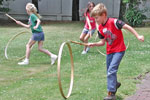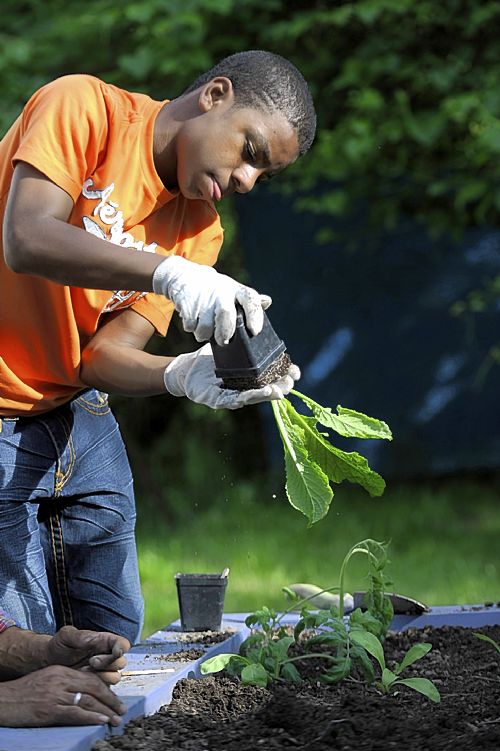
Category Archive: Education
-
Kids Can Get Hands on With Historical Games at Old Economy Village
By Kellie B. Gormly, PITTSBURGH TRIBUNE-REVIEW
Thursday, July 15, 2010Long before the days of battery-operated Buzz Lightyear toys and Wiis, kids had to get pretty creative in order to make toys and play games.
Children in the 19th century would amuse themselves with activities like rolling hoops with sticks, and doing “Lady Ann’s ring tosses,” which involved a stick tied to a wooden circle about the size of a doughnut. Kids would toss the stick around, and try to catch the circle with it. In another old-fashioned game, quoits, people would throw rings to land around a peg in the ground. Many of the toys were made with scrap wood that came from building houses.
“They had to make their own toys, mostly,” says Lynn Popovich, who is organizing a play-themed event at Old Economy Village this weekend. “You couldn’t go to the store and buy them. … Most of the toys back then were creative things that the parents sort of invented when the kids were little to keep them busy.”
On Saturday, Old Economy Village — which re-opened in April, after a state budget crisis closed the National Historic Landmark for a few months — will let its visitors explore, learn about and try out toys and games from the 1800s, when the Harmonists from Germany settled the Beaver County village. Hands On History Day features the old-fashioned amusements, along with arts and crafts, sack races, a historical scavenger hunt, and more. Kids can get their pictures taken while wearing reproduction 19th-century clothing, attend an 1830s schoolhouse session, watch puppet shows, play old instruments like kazoos, and more.
The activities will allow visitors of all ages to step back in time and enjoy getting a feel for early American life, says Popovich, who is the village’s volunteer coordinator and store manager.
“We just want them to come and have a fun time and experience the days of yore … with their children,” she says. “It’s something for the entire family. There aren’t a lot of activities where kids and parents can enjoy themselves together. They can walk around the garden, pavilion and gazebo, sit on the bench and reflect how people lived back then.
Kids, Popovich says, are “fascinated, I think, with how the children of yesterday lived, without the modern conveniences.”
“They love playing with the old-fashioned toys,” she says. “You wouldn’t think that they’d be interested because they’re so involved with iPods .. and all that high-tech stuff.”
Hands On History Day includes demonstrations from a blacksmith, weaver, broommaker, baker and other artisans, and visitors can try out these activities, Popovich says. The Ambridge Steel Drum Band will be performing at 1 and 3 p.m. Hot dogs, drinks and other snacks will be sold.
During school tours at the village, she says, the kids are fascinated by how their predecessors amused themselves without batteries and electricity.
_______________________________________________________________________________________
Hands On History Day_______________________________________________________________________________________When: 10 a.m.-5 p.m. Saturday
Admission: $9 for age 11-64; $6 for ages 3-11; $8 for age 65 and older; free for age 2 and younger
Where: Old Economy Village, 270 16th St., Ambridge, Beaver County
Details: 724-266-4500 or website
-
Former Turtle Creek High School’s Architecture, Importance Honored
By Tom Fontaine
PITTSBURGH TRIBUNE-REVIEW
Thursday, July 15, 2010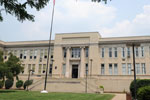
On Saturday, officials will unveil two historical markers that commemorate the former Turtle Creek High School building's architectural significance and role in the community. Officials debated about demolishing the building five years ago, but a group led by former graduates Jill Hinkle, Bob Mock, Jeanne Flaherty and Connie Morenzi led vocal opposition. The Classical Revival-style, cream-colored brick building with stone and terra cotta trim was designed by Pittsburgh architect George Henry Schwan. Jasmine Goldband | Tribune-Review
The former Turtle Creek High School building has gone by several names and narrowly avoided the wrecking ball to remain a community centerpiece since opening during World War I.
On Saturday, officials will unveil two historical markers that commemorate the Monroeville Avenue building’s architectural significance and role in the community.
Although the markers were installed last week, the building was placed on the National Register of Historic Places three years ago and received historic designation last fall from the Pittsburgh History and Landmarks Foundation.
“It basically validates what people in Turtle Creek have felt all along,” said councilwoman Jill Henkel of the markers. Henkel is a 1978 graduate of the former Turtle Creek High School and one of four Turtle Creek natives who led a push to obtain historical designation for the building.
Ground was broken on the $200,000 building in August 1917, and it opened in February 1919 as Union High School, with students from Turtle Creek, Wilmerding, East Pittsburgh and parts of nine other communities, according to documents related to the National Register of Historic Places designation.
The Classical Revival-style, cream-colored brick building with stone and terra cotta trim was designed by Pittsburgh architect George Henry Schwan. He also designed the Twentieth Century Club’s original building in Oakland, the former Oakmont High School and laid out plans for factory-worker developments in Aliquippa and Akron, Ohio.
The building wasn’t home to just high school classes.
Westinghouse employees trained at night in classrooms and vocational shops. Women used school sewing machines after hours to earn money during the Great Depression. And the school’s large lawn provided “the only open green space in the borough,” Henkel said.
“Even today, people are always playing in it,” Henkel said of the lawn. “It’s basically a community park.”
The school would hit a peak enrollment of more than 2,100 students in the 1930s. Also in that decade, after East Pittsburgh and Wilmerding opened their own high schools, Union’s name was changed to Turtle Creek High School. In 1940, the school graduated just 365 students.
When Turtle Creek became part of the newly created Woodland Hills School District in the 1980s, the building became the new district’s East Junior High. Officials debated about demolishing the building five years ago, but a group led by former graduates Hinkle, Bob Mock, Jeanne Flaherty and Connie Morenzi led vocal opposition.
Ultimately, the district moved East Junior High students elsewhere and mothballed the Turtle Creek building for the 2008-09 school year; it reopened last August, housing the district’s new Woodland Hills Academy for elementary students.
“I would have laid down in front of the bulldozer if they tried to tear down the building,” said Mock, a 1968 graduate.
The unveiling of the marker, part of Turtle Creek Community Days festivities, begins at 7:30 p.m. on Saturday at 126 Monroeville Ave.
-
Steel Valley Agency Eyes Old Gym For After-School Use
By Chris Ramirez
PITTSBURGH TRIBUNE-REVIEW
Thursday, July 15, 2010
Christian Michaels, 8, shoots hoops during a summer camp at Homestead United Prebyterian Church in Homestead. The camp is organized by the Methodist Union of Social Agencies, or MUSA, which wants to run after school programs for middle school children in the Steel Valley Council of Governments' gymnasium. James Knox | Tribune-Review
Decades ago, the old gymnasium attached to the Steel Valley Council of Governments building was the place to go for pick-up basketball games and summer youth camps.
Not so much now.
Amid the walls, streaked with unsightly graffiti and time-yellowed pin-ups, the Rev. Jim Cannistraci sees potential.
He and a small-but-growing band of community leaders are trying to generate local support — and money — to convert the aging gym into a state-licensed center for programs that cater to middle school children.
“This isn’t my dream. It’s the dream of the community,” said Cannistraci, executive director of the Methodist Union of Social Agencies. “People want this and people need this.”
They envision starting a program that would see to the needs of children from West Homestead, Munhall and Homestead, where half the population is black and one in four residents lives below the poverty line, according to U.S. Census figures.
Among services Cannistraci hopes can be offered at the center would be help with homework, access to computer labs and career exploration sessions. The Methodist Union wants the program to start Sept. 1, but needs to raise more than $100,000 before then for improvements to the gym.
Cannistraci envisions the program serving about 50 students by the end of the upcoming school year, but expects it eventually to cater to as many as 125.
“A lot of kids get out of school at three, but their parents are still at work. That’s also when they face a lot of temptation to do things that can get them in trouble,” said Douglas R. Spencer, executive director for the Allegheny Children’s Initiative, a South Side nonprofit pushing for the change. “That time needs to be occupied with structured activities.”

RaVyn Wright, 9, (left) and Edaiza Sands, 10, have fun playing computer games during a summer camp at Homestead United Prebyterian Church in Homestead. The camp is organized by the Methodist Union of Social Agencies, or MUSA, which is looking to generate funds to renovate the former gym and building that belonged to Homestead High School for an after school program that would see to the needs of children from West Homestead, Munhall and Homestead.
Homestead does not have a YMCA, Boys and Girls clubs or a private community center for middle school students to go to in the afternoon as neighboring communities do. A local chapter of the Salvation Army offers a free after-school program for children ages 6 to 12, and Methodist Union of Social Agencies holds after-school programs at Barrett and Park elementary schools.
For more than 80 years, the Methodist Union has aided families and children of the Mon and Steel valleys. The past three decades have been among the most challenging as the two areas struggle to find solid financial footing in the wake of the steel industry’s collapse.
Last week, the Steel Valley Council of Governments, which owns the gym, examined the prospect of an after-school program at a public meeting.
The gym for years belonged to Homestead High School and often was the backdrop to basketball games and large student assemblies. But that changed in 1979 when the Homestead school district merged with West Homestead and Munhall to form the Steel Valley School District.
The Allegheny Works program, which offered job-training programs and operated out of the old high school as the collapse of the steel industry began in the 1980s, used the gym for workshops for many years. These days, however, the gym is used only sparingly.
The Steel Valley Council of Governments says the gym is habitable, but $750,000 is needed to make it usable for a variety of purposes in addition to the after-school program.
-
Fallingwater Cottage Designs on Display at Carnegie
By Kurt Shaw, PITTSBURGH TRIBUNE-REVIEW
Wednesday, June 30, 2010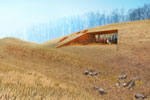
The jury chose the entry of Patkau Architects as the winner of this first-ever design competition. Their design shows that the juxtaposition of the project to Fallingwater is not as important as the juxtaposition of the project to the landscape, being that it proposes building the cabins into the rolling hillside. Patkau Architects
Located in Mill Run, just 90 minutes by car southeast of Pittsburgh, Frank Lloyd Wright’s Fallingwater is an icon of 20th-century architecture that draws approximately 150,000 admirers from around the world, all year long.
Built between 1936 and 1939 for the Kaufmann family — owners of the Pittsburgh department store — it was intended to be a second home, a vacation retreat deep in the woods, hovering above a small waterfall in Bear Run.
Today it stands alone, as it did in 1963, when Edgar Kaufmann Jr. transferred ownership of the house and landscape to the Western Pennsylvania Conservancy. But imagine, if you will, what it would be like if the surrounding Bear Run Nature Reserve, which has grown to 5,061 acres, were filled with cabins, like the countless other cabin-filled enclaves located throughout Western Pennsylvania?
As Fallingwater reaches its 75th anniversary, the conservancy decided to answer that question by inviting six architectural practices — three from the United States and three from Canada — to design cottages for a site a short distance from the main house.
All six proposals are currently on display at Heinz Architectural Center at the Carnegie Museum of Art in the exhibit “Design Competition: New Cottages at Fallingwater.”
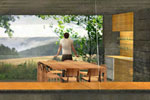
The second-place winner was Wendell Burnette Architects. Their proposal would be above ground, but integrated nonetheless among the forest. Wendell Burnette Architects
The participating firms, each known for environmental sensitivity, are Marlon Blackwell Architect, Fayetteville, Ark.; Wendell Burnette Architects, Phoenix, Ariz.; MacKay-Lyons Sweetapple Architects, Halifax, Nova Scotia; Olson Kundig Architects, Seattle, Wash.; Patkau Architects, Vancouver, British Columbia; and Saucier + Perrotte Architectes, Montreal, Quebec
Each practice was allowed four 24-inch-by-36-inch boards and one model representing a typical cottage unit. The firms were encouraged to give their own unique spin on it, with the additional goal of creating a sustainable design.
Intended to house students and/or teachers during onsite residency programs, the structures were planned to be LEED-certified platinum, which is energy efficient, site sensitive and low-maintenance. All of this in a tidy little package of about 700 square feet, including a small kitchen, open space with a fireplace and a bathroom.
“The architects were challenged to critically engage Wright’s formidable legacy and to address contemporary concerns regarding ecology and sense of place,” says Raymund Ryan, curator of architecture at the Heinz Architectural Center, and one of eight members of the competition jury.
The jury chose the entry of Patkau Architects as the winner of this first-ever design competition. Their model is located in the center of the exhibit.
Established in 1978, the firm has built many houses, schools and cultural institutions in British Columbia, structures characterized by articulate detailing, sheltering roofs and close attention to site.
Across Canada, Patkau Architects also are responsible for the Canadian Clay and Glass Gallery in Waterloo, Ontario, and the Grande Bibliotheque de Quebec in Montreal. For Fallingwater, they envisage sections of standard steel covered in fill, as “an intensification of the swelling ground-plane of the meadow.”
Here, their design shows that the juxtaposition of the project to Fallingwater is not as important as the juxtaposition of the project to the landscape, being that it proposes building the cabins into the rolling hillside. “It is of the hill, not on the hill,” Ryan says.
At first glance, it appears to be the most simple of all six on display. But look closer, and it’s easy to see why this proposal stood out for the jurors. It could be one or two units or even eight or nine. It is a natural system and has a collective quality.
“It appears simple but is well-integrated and thoughtful,” Ryan says. “It will be a fantastic, unique experience inside.”
The second-place winner was Wendell Burnette Architects. Their proposal would be above ground, but integrated nonetheless among the forest.
Like the Patkau design, the basic design could be expanded into multiple units. “Each cottage would be quiet, modest, but important in its conversation with nature,” Ryan says. “The architecture is not deferential, but respectful.”
The design of Olson Kundig Architects was chosen as the third-place winner.
Highlighting two aspects of the landscape surrounding Fallingwater — the forests and the fields — the project considers flow of people as well as the flow of land. “The unit is a response to how people gather and suggests how landscapes can be gathered and bridged,” Ryan says.
All three of these designs incorporate the use of energy-efficient and environmentally friendly building materials. Each of these cottages would be situated to take full advantage of natural heating and cooling opportunities and to minimize environmental impacts. Plus, each could be easily maintained during three seasons and just as easily closed over the winter.
Patkau Architects’ winning design for six small, efficient, sustainable cottages will serve as the basis of a final design, to be implemented following regulatory approval and fundraising.
These new cottages will serve an important outreach goal by expanding lodging capacity for participants in Fallingwater Institute’s diverse educational programs.
‘Design Competition: New Cottages at Fallingwater’When: Through Aug. 22. Hours: 10 a.m.-5 p.m. Tuesdays-Saturdays; until 8 p.m. Thursdays; noon-5 p.m. Sundays
Admission: $15; $12 for senior citizens; $11 for children and students; free for age 2 and younger
Where: Heinz Architectural Center at Carnegie Museum of Art, 4400 Forbes Ave., Oakland
Details: 412-622-3131 or website
-
Hill Innovation Center Gets State Funds
Thursday, July 08, 2010By Joe Smydo, Pittsburgh Post-Gazette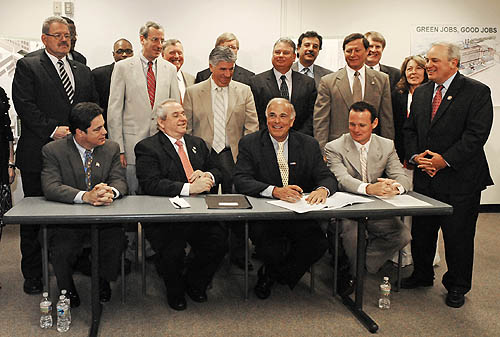
Surrounded by members of the Urban Redevelopment Committe and the Pittsburgh Gateways Corporation, Gov. Ed Rendell signs the economic development portion of the 2010-11 state budget to help create jobs.
Gov. Ed Rendell on Wednesday announced up to $8 million in state funding for a green innovation center in the Lower Hill District that may begin operations by fall.
Pittsburgh Green Innovators — to be housed in the former Connelley vocational-technical school — will be a home for new companies and training programs with an environmental theme.
In a sign of the project’s importance, Mr. Rendell traveled to the location to announce the funding for that project and sign the legislation creating the $600 million development fund, called the Redevelopment Assistance Capital Program.
“Pittsburgh has probably transformed itself more than any other American city, and that transformation is ongoing. It doesn’t stop. Green energy is the way of the future,” he said.
In all, about $300 million of the money already has been earmarked for projects statewide.
That includes the $8 million for Pittsburgh Green Innovators and up to $30 million to lure a federal vaccine production center to Allegheny County. The center, proposed by the University of Pittsburgh Medical Center, would produce vaccines needed to defend against biological attacks.
Recipients of the state money must match it dollar-for-dollar with funds from other sources.
Pittsburgh Gateways, a Lawrenceville economic-development group that’s spearheading the green innovation center, is negotiating with Pittsburgh Public Schools to acquire the 300,0000-square-foot former Connelley building. Robert Meeder, president of Pittsburgh Gateways, said he hopes to close on the deal as early as September.
He said the first phase of renovations — focusing on 80,000 square feet but including the installation of environmentally friendly energy systems throughout the building — could begin in the first half of 2011. He said that work will cost about $26 million, while a later phase of renovations, covering the rest of the building, would cost an estimated $19 million more.
Officials have said public school classes, apprenticeship programs and college classes all would be offered at the center, allowing students to train for careers with an environmental focus.
In a sense, the building — employing solar, geothermal and other alternative energies — will be a giant classroom, Dr. Meeder said.
The first classes may begin in the fall, he said.
The building also will serve as an incubator for start-up businesses. Dr. Meeder said as many as 14 fledging companies may have space there by the end of 2011.
State Sen. Jim Ferlo, D-Highland Park, an early proponent of the project, said the center already received $4 million from a previous pot of Redevelopment Assistance Capital Program dollars. The project also has received about $2 million in federal aid, and Dr. Meeder hopes to lure $7 million from corporate and foundation sponsors.
-
South Park Middle School Outdoor Classroom to Serve Double Duty
Thursday, July 08, 2010Howard Anderson said his smelly, sometimes boisterous lesson plans don’t do anything for his popularity in the teachers lounge at South Park Middle School.
“We’re dissecting fish and the room stinks or we’re making bottle rockets,” the fifth-grade science teacher said last week as he and a small crew of laborers worked to assemble the wooden structure for an outdoor classroom that he hopes will double as a memorial garden..
Mr. Anderson said he began mulling the concept in May 2009, three months after his friend and fellow science teacher, Marilyn Walsh, died from pancreatic cancer. He said he wanted to honor Mrs. Walsh by creating a lasting memorial combining two of her favorite things: teaching and tiger lilies.
His vision turned into a pet project after he helped secure a $5,000 grant from Lowe’s and a contribution from Consol Energy to fund the facility, which will be located behind the middle school.
But Mr. Anderson said that while he was thankful for the funding, a few thousand dollars doesn’t go far when it comes to building a 20-by-20-foot structure with an asphalt floor and gabled roof.
In fact, he said the project may have faltered without Stephen Bornyas, owner-operator of Bornyas Residential Construction of Boston, who offered to complete the structure for what Mr. Anderson said was a significantly reduced rate.
Mr. Anderson said he reached out to Mr. Bornyas after Internet research led him to a story about the company building a similar outdoor classroom at Elizabeth Forward School District.
Mr. Bornya said he expected the project to take two days for his crew to complete. Gabe Gehenio of Gabriels Excavation also worked at a reduced rate to help.
Once the structure is finished, phase two — installation of a garden hugging the perimeter of the outdoor classroom — will begin.
Mr. Anderson said that he hopes the outdoor classroom will help other teachers add flexibility to their lesson plans and that the space will be used for instruction, as well as a quiet place for members of the community to eat lunch or quietly reflect.
But he was clear: The outdoor classroom is an evolving science project in its own right.
“I don’t want it to end,” he said. “I want it to get bigger and better and improve every year.”
And he said anytime his dedication wavered, he thought of what Mrs. Walsh would have done.
“She inspired me because she came to school sick and she came tired,” Mr. Anderson said, adding that even when the teacher was in the hospital she called to see how her students had fared on their standardized tests.
Mr. Anderson said the memory of Mrs. Walsh has also inspired him to create a horticultural club at the middle school, which will help interested youngsters learn more about the art of cultivating flowers while also ensuring the garden is maintained.
He added that he will be looking for funding to add an alternative energy source. Mr. Anderson said one day he would like to incorporate solar panels or a wind turbine, which would complement both the facility itself, as well as its capacity for educational enrichment.
But until then, he said he looks forward to fall, when he’ll be able to test drive the new classroom.
Anything that smells pretty awful or that concentrates on fire tends to work better outdoors, anyway, Mr. Anderson said.
Middle school principal Kevin Monaghan lauded the project and Mr. Anderson for his creativity at a time when students standardized test scores are often the focus.
“It makes lessons more relative to the students,” Mr. Monaghan said. “Something like this makes all the difference.”
-
Cities, Including Pittsburgh, Are Turning Green With Urban Farms
Thursday, July 08, 2010By Diana Nelson Jones, Pittsburgh Post-GazetteThe urban farm — a novel, even whimsical, idea a few years ago in Pittsburgh — is now a movement so fully fledged that a neighborhood without one seems almost an anomaly.
Nationally, the movement is profuse, with seeds in the 1980s when foodies sprouted and gourmet eating went mainstream. The roots of several movements have intertwined since: urban enterprise farms, urban farms for educating children, community gardens, vacant lot greening, soil remediation of industrial landscapes, community supported agriculture, backyard chickens and bee hives, consumers who buy into livestock with farmers and grocery chains selling local produce.
Grow Pittsburgh, whose mission is to support urban gardening, is a 5-year-old nonprofit that can’t keep tabs on the number of gardens being planted in the city’s public spaces, said Julie Butcher Pezzino, executive director.
Grow Pittsburgh is a partner of groups operating gardens in Braddock, Lawrenceville, Larimer and Lemington. It is searching for a suitable plot Uptown and has Troy Hill and Hazelwood on schedule for next year.
An online search of terms such as “urban farm,” “sustainable food” and “buy local” shows how robust the movement is in other cities. Interest here has skyrocketed.
Grow Pittsburgh’s latest foray is to widen its scope. It is working with Allegheny County and the Western Pennsylvania Conservancy in a pilot program to encourage gardening partnerships outside the city. It is currently developing projects in Millvale and McKees Rocks.
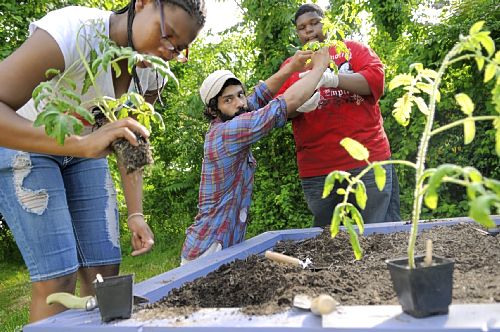
Rebecca Droke/Post-Gazette --- Jayda Harden, 14, left, with Mark Williams, center, and Brandon Kenney, 14, plant tomatoes in a raised bed for the Lots of Hope gardening project at The Pittsburgh Project on the North Side.
It has also collaborated with McAuley Ministries, the granting arm of Pittsburgh Mercy Health System, GTECH Strategies, the Pittsburgh Housing Authority, the A. Randolph Institute and the Greater Pittsburgh Community Food Bank to create the Francis Street Community Garden and Urban Farm Project on approximately 1 1/2 acres at Bedford Avenue and Francis Street in the Hill District.
McAuley Ministries granted $37,580 to the project. Produce from that garden will be sold to the Greater Pittsburgh Community Food Bank for distribution through a farmers market and farm stands located at the Hill House and Addison Terrace.
“In the last two or three years, we have gotten calls upon calls from people asking for help and technical assistance” in starting a community farm, said Ms. Butcher Pezzino. “We are still developing our policies” on partnership standards. “It’s new for us to be helping so many groups.
“One of our goals is to start trying to document and find where all the places are” that have not relied on Grow Pittsburgh’s help. “I’ve gotten calls from people asking if we are partners in gardens that I have never heard of.”
A lot of things happened last year to help the momentum nationally:
The U.S. Department of Agriculture’s “Know Your Farmer, Know Your Food” campaign kicked into gear last summer, giving USDA employees the directive to consider starting their own gardens.
First Lady Michelle Obama planted a kitchen garden at the White House.
The movie “Food Inc.” opened a lot of eyes to the ways and means of corporate food agriculture.
The movement is further bolstered by occasional recalls and reports of tainting.
Among the oldest and most successful urban agriculture projects are the Food Project in Massachusetts, which started in 1992 and has mushroomed to include numerous acres throughout the Boston area, including inner-city Roxbury. It has 25 full-time staff, employs 100 youth and attracts 2,000 volunteers each year. It sells and donates more than 250,000 pounds of food each season. It is also a source of food for community-supported agriculture, or CSA, subscribers.
Will Allen’s Growing Power Inc., founded in 1995 in Milwaukee, was recently hailed at the Women’s Health & the Environment Conference in Pittsburgh. Growing Power has become a national advocate that trains and offers technical support to communities in growing food and selling it.
Urban Farming, a Detroit nonprofit, grew from a pilot of three gardens in 2005 to 600 gardens across the country today. Its mission is to take over vacant space, grow food and give it away to people who live nearby.
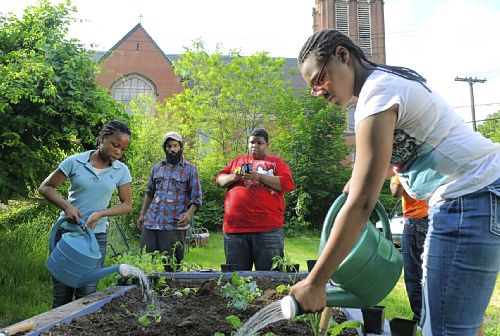
Rebecca Droke/Post-Gazette --- Ceasia Williams, 14, left, and Jayda Harden, 14, water newly planted seedlings in a raised bed for the Lots of Hope gardening project at The Pittsburgh Project on the North Side.
Braddock Farms was not the area’s first big garden on public land when Grow Pittsburgh established it in 2007, but it set a standard for what “urban farm” means locally. On three-quarters of an acre, it may be the largest nonprofit farm in Allegheny County and is the leading “enterprise” farm. A dozen area restaurants buy produce from it.
“We have developed a market base within the high-end restaurant community for our produce from there,” said Ms. Butcher Pezzino, “but it is not yet sustaining itself.”
The Pittsburgh Project in Perry South has expanded the size and scope of a teaching garden for its summer youth over three years. The Lots of Hope project not only broadens children’s understanding of food and nutrition, it also teaches them how to run a small business — a farm stand — and the value of supplying food to their neighborhood.
“We started the farm as a food access initiative,” said Jonathan Young, an AmeriCorps worker. The neighborhood is hilly and lacks a grocery people can walk to. The Project last year got the city’s permission to farm on an abandoned baseball field near its Charles Street campus. It will expand its Thursday farmers market and deliver what it doesn’t sell to the elderly in nearby high-rises.
The Thursday farmers market season at the Project began June 10; the hours are 2 to 6 p.m.
Last year, Mr. Young said, the farm stand made enough to cover its costs; infusions of food from the Greater Pittsburgh Community Food Bank help during lean growing times.
“My hope this year is that 30 percent of the operating budget is covered by revenues from our farm stand,” he said. The Project has its first commercial buyer of produce — Bistro to Go on East Ohio Street in Deutschtown, which is also sharing its organic waste so the Project can accumulate compost.
“These are exciting times,” said Mr. Young.
Grow Pittsburgh’s sites include the Larimer Farm and Gardens, a quarter acre at Larimer Avenue and Mayflower Street; Lawrenceville Gardens at Allegheny Cemetery, about 150 square feet; and a garden the size of four city lots on Lincoln Avenue in Lemington called Higher Ground Community Garden.
The Larimer site got grant funding so Grow Pittsburgh could hire a part-time manager, said Ms. Butcher Pezzino, “someone who is there 20 hours a week and can keep it looking good. That could be an awesome model.”
Larimer’s site is a community garden and a farming effort of the Larimer Green Team.
“They’re calling it a farming garden” with hopes of becoming vendors, “but the market is still being tested” as to how much an enterprise garden can make above its expenses, she said.
Interest from residents who want plots shot up from seven requests last year to 20 this year, she said.
Ebony Earth started the Higher Ground garden with Grow Pittsburgh’s help in 2007 as a green hobby, she said. “The whole point was to get the community living a healthier lifestyle.” She has been giving the produce to neighbors but said she might look for a commercial outlet and offer plots for neighbors to grow their own food. She and the other volunteers who garden the lots have been supported by the Greater Pittsburgh Community Food Bank’s farm-stand program, which offers help, supplies and produce when the farm stand is low on inventory.
All of these gardening projects focus on making fresh local produce affordable to the people who have the least access to it.
“Whole Foods could be in this neighborhood and it wouldn’t matter,” said Mr. Young. “If it’s not an effort like ours, our neighbors can’t afford to eat well.”
-
A Newsmaker You Should Know: Historical Society Chief Links Past to Present
Thursday, July 08, 2010Marilyn Albitz barely passed high school history — a close call she attributes to a teacher who she said wanted her students only to memorize dates.
“I was an A student, but [historical] dates always turned me off. Rather, I’ve always liked to hear stories about the people, what they did, where they came from,” Ms. Albitz recalled.
MARILYN ALBITZAGE: “I’m a senior citizen, that’s all I’ll admit.”
OCCUPATION: Community volunteer
EDUCATION: Dormont High School
FAMILY: Husband, Robert; three children; seven grandchildren
WHAT’S IMPORTANT TO YOU? “My family and my borough’s history.”
PEOPLE WOULD BE SURPRISED TO KNOW: “I was once very shy. Now all I do is talk.”
FIRST JOB: Office supervisor at Prudential Insurance
HOBBIES: Reading and traveling
READING MATERIAL ON YOUR NIGHTSTAND: Romance novels and trivia books
WHAT’S PLAYING ON YOUR TV: “The Mentalist,” “The Good Wife,” “NCIS: Los Angeles,” “Jeopardy!”
GUILTY PLEASURE: Chocolate candy
FAVORITE SPOT IN THE WORLD: Green Tree. “There’s no place like here.”
MOST EMBARRASSING MOMENT: “I’m sure there have been plenty, but I can’t think of any to share now.”
PROUDEST MOMENT SO FAR: “I’m proud of my family. And I was very proud being invited to Harrisburg.”
Now, as Green Tree Historical Society president, she is learning history the way she likes it: stories of the people who have lived in her community and the surrounding area.
“People influence other people. Our history is like a puzzle, and with each story, you get another piece,” she said.
Ms. Albitz credits former Green Tree librarian Roberta Antin as her greatest influence.
“She took me under her wing,” Ms. Albitz said. “She was our historian before we had the historical society. She collected stories, photos, newspapers, everything she could.”
Ms. Albitz started Green Tree’s historical society 25 years ago and has since helped other local communities start theirs, including Brentwood, Carnegie, Crafton, Dormont, Ingram, Mt. Lebanon and Reserve.
“I’d just take a folder of information and go talk to people about what we do and how we did it,” she said.
She wanted to help other communities start their historical societies for the same reason she wanted to start Green Tree’s.
“It’s important for you to know what your community is and was and where it’s going,” she said. “It’s important to collect more than Green Tree’s history because all these communities were once connected.”
State Rep. Matt Smith, D-Mt. Lebanon, hosted Ms. Albitz in Harrisburg last month to recognize her efforts in organizing Green Tree’s 125th anniversary celebration.
“[Ms. Albitz] herself is a community treasure. She is truly the kind of person that makes Green Tree and surrounding communities so special,” he said.
Mr. Smith was a history major at Rollins College and said there was “a huge advantage to preserving each community’s heritage. [Ms. Albitz] does a great job preserving that history.”
But talking to groups interested in forming their own historical society wasn’t easy for Ms. Albitz decades ago.
“I was so shy,” she said. “I took a public speaking class at the community college to help me get past that.”
During the class, she learned a lesson that she still relies on today.
“Just be yourself. You know more about what you’re talking about than the people you’re telling it to,” she said.
A lot of people have benefited from the information Ms. Albitz has shared and she’s been “very valuable to the community,” according to Dave Montz, Green Tree manager.
“People have been able to trace their roots, and she’s worked with children, too. They’ve learned where they live wasn’t always a traffic-congested, busy town. It was actually once farmland,” he said.
Ms. Albitz said she was a natural organizer growing up in Dormont with three brothers and one sister.
Later, she worked as an office supervisor for 13 years at Prudential Financial Inc. in Kennedy before starting a family. She has three children — David, Linda and Jeffrey — and seven grandchildren, ranging in age from 2 to 22.
As a mother, she served as a leader in the school’s Parent Faculty Organization.
In addition to her leadership in Green Tree’s historical society, she is president of the borough’s seniors’ club and belongs to its women’s club.
“People tell me I do too much and that I should learn to say ‘no.’ But you can’t say ‘no’ to stuff that interests you,” she said.
Reading is another of Ms. Albitz’s interests.
“I love romance novels. So many of them take place in different countries, and I love those settings. I skim over most of the romance. At my age, who cares?” she asked with a laugh.
Ms. Albitz does not disclose her age but did offer that she was married in 1953 to her husband, Robert, at St. Bernard Church in Mt. Lebanon.
“Compromise is the key,” she said of her nearly 60-year marriage. She also joked that it might help that she’s rarely home because of her work with social groups and traveling with the seniors’ club.
“I’m not home much, but I love to bake when I am,” she said.
Her favorite recipe is for her mother’s pumpkin pie, and she also likes to bake cookies.
“Grandma always has a can of cookies in her freezer,” she said.
She would spend more time baking if she had the time, she said, but there’s still too much to be done at the historical society.
“I’ve got to find someone to take this over after I’m gone,” she said. “I thought I’d retire this year, but I can’t. I’m still learning too many new stories.”

